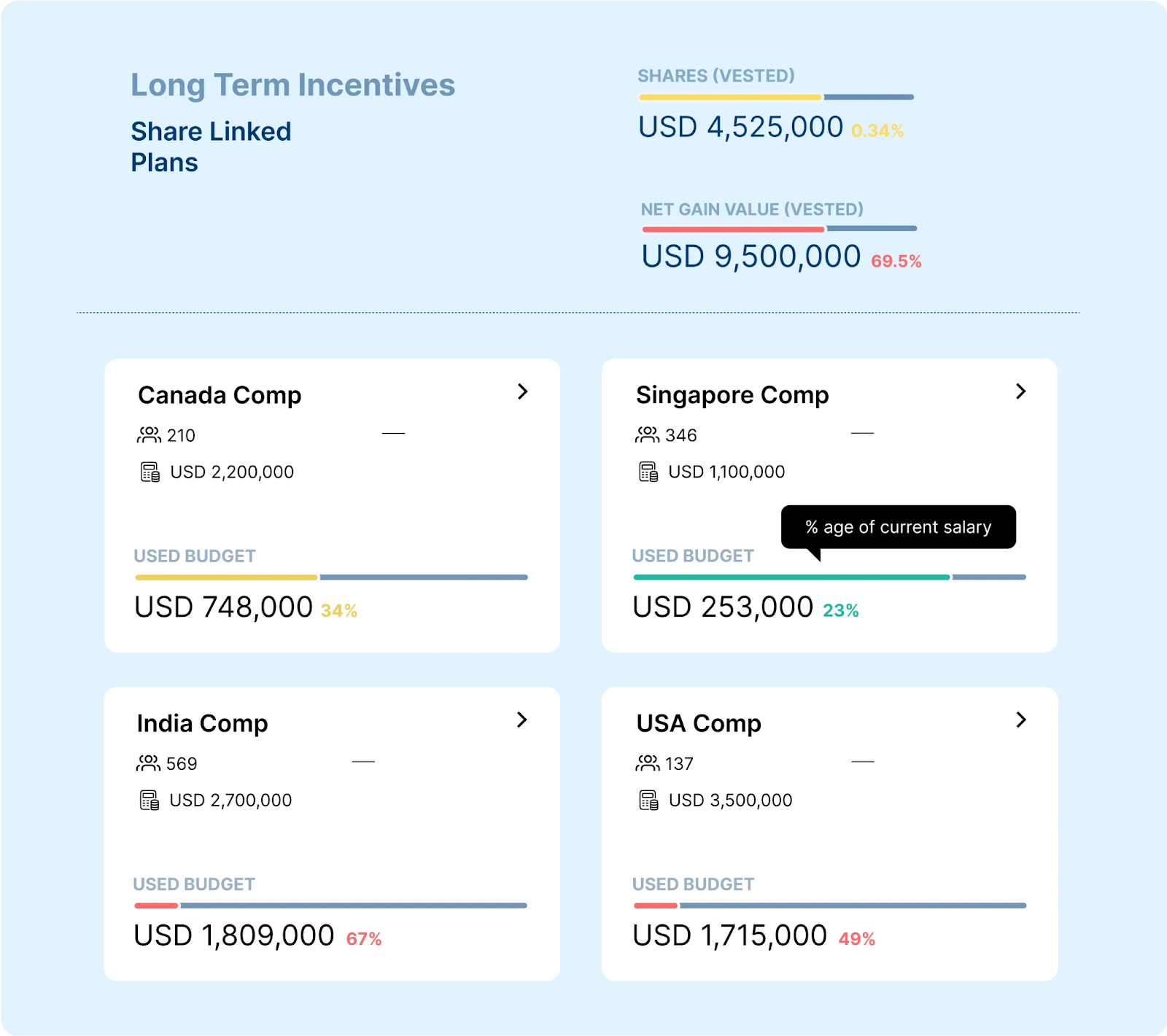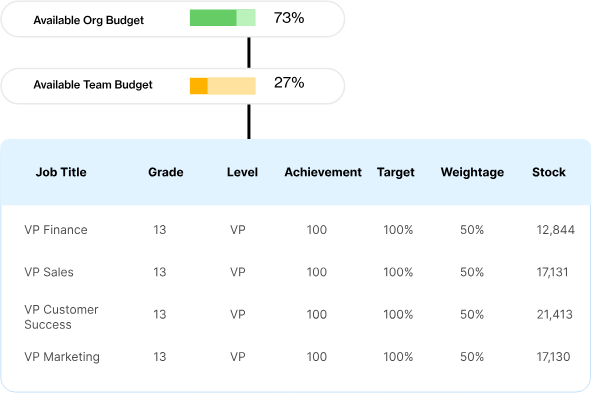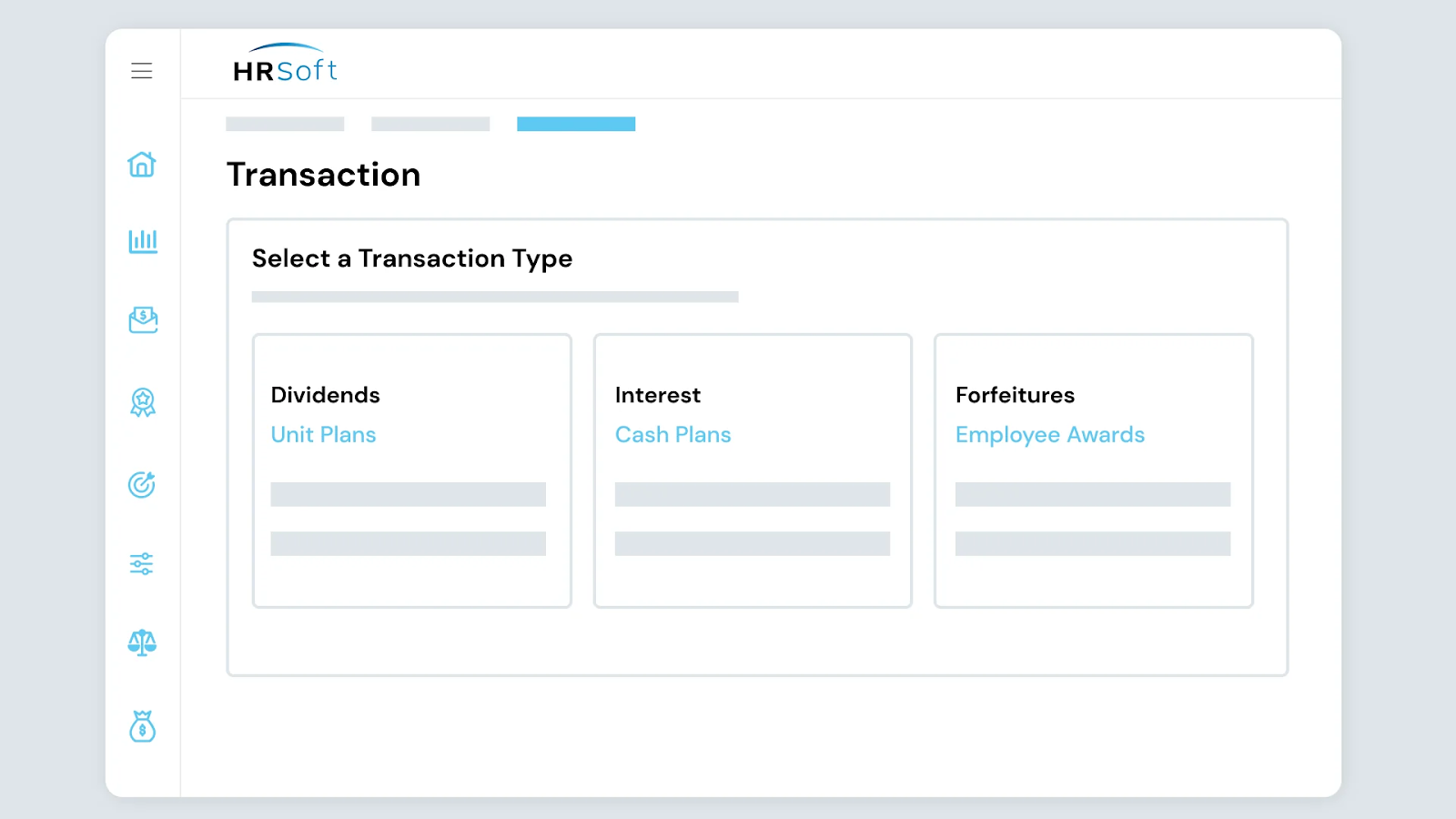[Reviewed] 5 Best LTI Management Software for Comp and Rewards Teams in 2026
%20(37).png)
Managing long-term incentives, such as stock options and RSUs, is becoming increasingly complex for Rewards Teams. You're tracking grant values, vesting schedules, performance criteria, and tax implications across multiple years and thousands of employees.
For large organizations with over 10,000 employees, spreadsheets are no longer sufficient, and the margin for error is too high. That's where Long-term Incentive (LTI) management software comes in.
These tools help compensation and rewards teams design, track, and communicate long-term incentive plans with greater clarity and efficiency.
In this article, we'll break down what LTIs actually are and review five software solutions worth considering in 2026. Let’s go!
What is LTI in Compensation?
Long-term incentives are compensation rewards that pay out over multiple years, designed to keep employees around and tie their success to the company's future performance. Unlike your base salary or annual bonus, LTIs typically vest after several years.
Think stock options, RSUs, performance shares, or deferred cash bonuses.
Below is an example of how the dashboard of an LTI platform looks for individual employees:

The setup usually involves vesting schedules, such as the standard four-year vest with a one-year cliff, where you earn portions of the award gradually after an initial waiting period. The goal is alignment: as the company's stock price or financial metrics improve, so does the value of your awards.
In tech companies and Fortune 500 firms, equity-based LTIs make up a substantial chunk of compensation for executives and key talent. They're often called "golden handcuffs" because that future payout gives people a reason to stay.
A Long-term Incentive Example from Netflix

Netflix takes an unconventional approach to equity compensation. Employees choose each year how much of their eligible compensation they want in salary versus stock options, providing the opportunity to benefit from Netflix's long-term success as the stock price appreciates. You can choose all cash, all options, or whatever combination suits you.
How it works:
- These 10-year stock options are fully vested, and you keep them even if you leave Netflix
- There's no waiting period - you can exercise the options immediately
- Employees control the mix and can adjust their choice annually
The philosophy: Netflix doesn't use unvested equity as a retention tool or "golden handcuffs." Their approach reflects a simple belief: if you find a better opportunity elsewhere, you shouldn't be locked in by unvested stock. Take what you've earned and go.
This differs dramatically from most tech companies, which use multi-year vesting schedules (typically four years with a one-year cliff) to encourage retention. Netflix's plan gives employees immediate ownership while still aligning them with the company's long-term success - just without the typical restrictions.
💡Explore more long-term incentive plan examples from leading companies!
5 Best LTI Management Software for Comp and Rewards Teams
Compport

Compport LTI management platform is a comprehensive compensation management platform serving over 300 customers globally, including Standard Bank, Aditya Birla Group, Visteon, Virtusa, Security Bank, Lmax Group, among many.
Compport specializes in managing complex LTI programs for large, multinational organizations with its powerful rules engine and deep configurability.
Top Features
Advanced rules engine for complex scenarios

Configure eligibility, vesting schedules, and grant calculations based on geography, grade, performance, tenure, and dozens of other criteria. Handle multi-country LTI programs with different regulatory requirements without manual workarounds.
Complete equity visibility for employees

Employees can view grants, vesting schedules, and exercise history in a single dashboard. Built-in equity simulator shows potential portfolio value based on different share price scenarios, increasing engagement and understanding.
Dynamic budget modeling and reallocation

Test allocation scenarios before committing, adjust budgets mid-cycle without disruption, and track utilization in real-time. Supports both bottom-up and top-down budgeting with precise proration for complex org changes.
Performance-based vesting automation
Linking to individual performance ratings and company metrics. Set multipliers that automatically adjust equity outcomes, create exception rules for top performers, and implement cliff vesting or graded schedules.
200+ pre-built compensation reports
Interactive dashboards with drill-down capabilities across location, department, gender, and grade. Export to PowerPoint, Excel, or PDF. Real-time alerts flag pay gaps or policy violations during the planning process.
Automated letter generation

Highly customizable templates show grants, vesting schedules, equity value projections, and total rewards breakdowns. Scale personalized communications across thousands of employees with conditional logic.
Pros
- Built for enterprises with multi-country, multi-currency LTI programs requiring granular eligibility rules and sophisticated vesting logic
- Manages base salary, bonuses, LTI, sales incentives, and pay equity in one system—no need for multiple tools
- Best-in-class reporting with multi-dimensional views and benchmark comparisons
- High-touch customer service team collaborates closely during implementation and annual cycles
Cons
- Newer platform compared to some legacy competitors
Here’s how you can create an LTI plan with Compport:
HRSoft

HRSoft is particularly strong in the financial services sector, where it has proven experience with unique program constructs, such as carried interest plans and highly complex bonus calculations.
Top Features
Formula-driven proration engine: Handles intricate proration logic, including tenure-based adjustments, geo-specific rounding rules, and nuanced leave-of-absence considerations.
Extensive administrative control: Admins gain near-complete autonomy to build and manage highly customized compensation processes with minimal vendor involvement.
Configurable hierarchy and security: A flexible user security model handles unique organizational structures and reporting relationships.
Comprehensive audit trails: Strong tracking of planner decisions with detailed reporting to support stringent regulatory environments.
Pros
- Deep configurability for sophisticated policies
- Strong validation and auditability for regulated industries
- Proven with unique financial services requirements (carried interest, complex bonus calculations)
- High administrator autonomy is once configured
Cons
- Dated user interface compared to newer platforms
- Planner experience lacks modern visual guidance
- More vendor support needed for complex configurations
- Analytics require additional customization for advanced insights
Beqom

Beqom is positioned as a comprehensive total compensation management platform used by Fortune 500 companies. The platform handles base pay, variable compensation, benefits, and long-term incentives with strong focus on global enterprises needing sophisticated compensation management.
Top Features
Global compensation management: Designed for companies managing compensation across multiple countries, currencies, and regulatory environments
Unified total compensation platform: Beqom Integrates all compensation elements—base salary, bonuses, commissions, benefits, and LTI—into a single system for complete visibility and management.
Advanced analytics and insights: Provides compensation analytics and reporting capabilities to track spending, analyze pay equity, and measure program effectiveness across the organization.
Pros
- Comprehensive platform covering all compensation types
- Strong integration capabilities with HRIS systems
- Mature platform with an established customer base
Cons
- It can be complex to implement and configure
- Requires significant IT resources for setup and maintenance
- Higher cost point suited for enterprise budgets
- It may be overkill for smaller organizations
💡Looking for a Beqom alternative? Read this detailed comparison!
OpenComp

OpenComp is suitable for small to mid-sized organizations (250-1K employees) seeking pragmatic tools for managing compensation cycles efficiently, with a strong focus on usability and a partnership approach.
Top Features
Intuitive administrative interface: Streamlined setup process with easy-to-use toggles for cycle configuration and eligibility management.
User-friendly planner experience, Clear visibility into compensation recommendations, eligibility statuses, and budgeting with minimal training required.
Integration with broader suite Integrates with OpenComp's market benchmarking and equity tracking modules for unified compensation management workflows.
Pros
- Intuitive for both admins and planners
- Fast implementation and adoption
- Strong compensation statement customization and employee portal
Cons
- Lacks dynamic validation and real-time decision support
- Limited native proration logic and modeling capabilities
- Analytics require external tools for more profound insights
Decusoft

Decusoft offers the Compose platform for long-term incentive planning. The platform focuses on automating complex commission structures and incentive calculations with strong capabilities for variable compensation programs.
Top Features
LTI and equity management: Tracks equity grants, vesting schedules, and exercises. Provides employees with a view of their long-term incentive portfolio and potential value.
Flexible calculation engine: Handles complex compensation formulas and business rules for different plan types. Supports multiple plan designs within a single platform.
Integrated reporting: Pre-built reports and dashboards for compensation analysis, plan performance tracking, and pay equity monitoring across the organization.
Pros
- Flexible calculation engine for complex formulas
- Good for organizations with heavy commission components
- Established platform with a proven track record
Cons
- More specialized in sales comp than holistic LTI management
- May require significant configuration for complex equity programs
- Integration with HRIS can require IT resources
- Less modern interface compared to newer platforms
What Features to Look for in a Long-term Incentive Management Software based on Employee Count?
Choosing the right LTI management software depends heavily on the size and complexity of your organization.
A 100-person startup has vastly different needs than a 10,000-employee global enterprise. As companies grow, their LTI programs evolve from simple grant tracking to sophisticated, multi-country equity strategies with performance-based vesting and complex compliance requirements.
Here’s a quick breakdown of what to look for in an LTI tracking tool based on your employee count:
0-200 Employees
What You Need:
- Simple grant tracking and vesting schedule management
- Basic employee self-service portal for equity visibility
- Spreadsheet alternative that reduces manual errors
- Easy setup with minimal IT requirements
- Affordable pricing for small headcount
- Quick implementation (under 4 weeks)
200-500 Employees
What You Need:
- Multiple plan type support (RSUs, stock options, PSUs)
- Role-based access for HR, finance, and managers
- Automated vesting calculations and notifications
- Basic reporting for budget tracking and utilization
- Integration with payroll for tax withholding
- Customizable grant letter generation
500-1,000 Employees
What You Need:
- Multi-currency support for expanding geographic footprint
- Workflow automation for grant approvals
- Performance-based vesting capabilities
- Equity simulator for employee engagement
- Audit trails for compliance requirements
- Pre-built analytics dashboards
- HRIS integration for employee data sync
1,000-5,000 Employees
What You Need:
- Sophisticated eligibility rules by location, level, and tenure
- Multi-tier approval workflows across business units
- Advanced proration for mid-cycle changes (transfers, promotions)
- Regional compliance tracking (SEC, tax regulations)
- Scenario modeling for budget planning
- Pay equity analytics integration
- Customizable Total Rewards Statements
- Support for complex vesting conditions (performance multipliers, cliff vesting)
5,000-10,000 Employees
What You Need:
- Multi-country, multi-currency, multi-entity management
- Granular security permissions across the global org structure
- Exception-based granting for high performers
- Real-time budget tracking with holdback capabilities
- Integration with global payroll systems
- Advanced performance vesting automation
- Comprehensive audit trails for SOX compliance
- White-glove implementation support
- Dedicated customer success management
10,000+ Employees
What You Need:
- Enterprise-grade scalability and performance
- Sophisticated rules engine for complex eligibility across divisions
- Dynamic budget reallocation mid-cycle without disruption
- Performance-based vesting with talent rating integration
- Advanced analytics with multi-dimensional reporting
- Custom calculation logic for unique plan designs
- Global compliance management (GDPR, local regulations)
- Change management and organizational restructuring handling
- API integrations with enterprise HCM systems
- Executive reporting and board-level insights
- Dedicated implementation team and ongoing support
Choosing the Right LTI Management Tool Your Organization
For companies with fewer than 1,000 employees, OpenComp and Decusoft offer the simplicity needed for straightforward LTI programs with one or two equity types across limited geographies. HRSoft and Beqom are ideal for companies with 500-1,000 employees when sophisticated workflows and compliance become priorities, especially in regulated industries.
Beyond 1,000 employees—and particularly past 5,000—LTI complexity increases significantly with the addition of multiple countries, currencies, business units, and regulations.
Compport is purpose-built for this scale.
- With 5,000-10,000 employees, its rules engine handles diverse eligibility criteria, performance-based vesting across regions, and dynamic budget adjustments that other platforms struggle to manage.
- For 10,000+ employees, Compport becomes essential rather than optional. With proven deployments at companies exceeding 70,000 employees, it delivers the configurability, governance, and analytical depth that global enterprises require.
Want to explore Compport?

FAQs
What features should I prioritize for my first LTI platform?
Start with core capabilities: grant tracking, automated vesting calculations, employee self-service portal, basic reporting, and grant letter generation. As you scale, add performance-based vesting, multi-currency support, advanced analytics, and compliance tools.
Can LTI software handle multiple types of equity?
Yes, modern platforms support various equity types, including stock options (ISOs, NSOs), RSUs, PSUs, phantom stock, and SARs. Most can manage multiple plan types simultaneously with different vesting schedules and eligibility rules for each.
What reporting capabilities should I expect?
Essential reports include grant activity summaries, vesting schedules, equity dilution analysis, budget utilization tracking, and tax withholding calculations. Enterprise platforms offer 100+ pre-built reports with drill-down capabilities across departments, locations, and employee segments.
How difficult is it to integrate with our existing HRIS?
Most LTI platforms like Compport offer pre-built integrations with major HRIS systems (Workday, SAP, Oracle, ADP, BambooHR). Integration typically involves API connections or scheduled file transfers. Implementation teams handle technical setup, though complex integrations may require IT involvement.
What data do I need to migrate from spreadsheets?
You'll need employee demographic data, grant history (including dates, amounts, and types), vesting schedules, exercise records, and current equity holdings. Most vendors provide migration support and templates to streamline the data transfer process.
Can we run the platform in parallel with our current process during the transition?
Yes, most implementations include a parallel testing phase where you run both systems simultaneously to validate accuracy before making the switch entirely. This is especially important for large organizations with complex programs.
At what company size should we move from spreadsheets to software?
Most companies transition between 50-200 employees when manual tracking becomes too time-consuming and error-prone. If you're spending more than 40 hours per quarter managing equity in spreadsheets, or if you've made grant errors, it's time to invest in software.
Will the software scale as we grow internationally?
Platforms like Compport are built for global scale, supporting multi-country, multi-currency operations with local compliance tracking. Ensure your chosen platform handles the specific countries in your expansion plans.
What level of vendor support should we expect?
Support varies by vendor and pricing tier. Expect email support as standard, with higher tiers offering dedicated customer success managers, implementation specialists, and priority response times. Enterprise platforms like Compport provide white-glove support during critical cycles.


%20(43).png)
%20(42).png)
%20(29).png)
